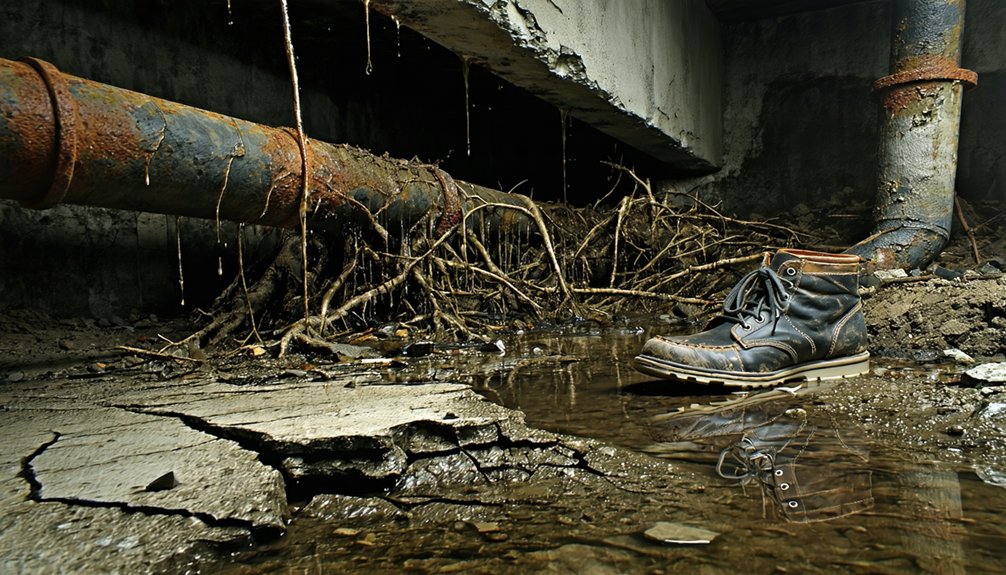Common signs of sewer line damage include frequent sewage backups in toilets, slow drainage across multiple fixtures, and foul odors emanating from drains. Gurgling sounds from toilets or drains indicate trapped air, while unusual patches of green grass in the yard may suggest leaks from broken pipes. Recognizing these indicators is essential for timely intervention. Understanding the associated health risks and necessary steps can further aid in addressing potential sewer line issues effectively.
Common Indicators of Sewer Line Damage
How can homeowners discern if their sewer lines are compromised? Several signs serve as critical indicators of potential sewer line damage. Frequent sewage backup, particularly in toilets, may suggest a broken sewer line rather than simple clogs caused by excessive waste. Additionally, slow draining sinks and tubs, especially when multiple fixtures are affected, warrant immediate investigation as they may point to underlying plumbing issues. Homeowners should also be vigilant for foul odors emanating from drains, indicating possible contamination within the sewer lines. Gurgling sounds from toilets or drains during use signify trapped air, often linked to blockages or full sewer lines. Unusual patches of green grass in the yard can suggest leaks from broken pipes, as they enrich the soil with organic materials. Mold or mildew growth in and around plumbing fixtures may further indicate sewer line deterioration, necessitating prompt sewer line repair to prevent extensive damage.
Health Risks Associated With Damaged Sewer Lines
Damaged sewer lines pose significant health risks, as they can lead to the release of harmful sewage gases such as methane and hydrogen sulfide. These gases can cause respiratory issues and neurological effects when inhaled, jeopardizing the well-being of individuals in proximity. Moreover, sewage-contaminated water from broken lines can expose individuals to infectious diseases, including hepatitis A and gastroenteritis, particularly through ingestion or skin contact.
The growth of mold and mildew resulting from sewer leaks contributes to deteriorating indoor air quality, exacerbating respiratory problems and allergic reactions for sensitive individuals. Additionally, damaged sewer lines can attract pests, such as rodents and insects, which introduce further health risks through disease transmission, including hantavirus and salmonella. Prolonged exposure to these contaminated environments poses significant long-term health effects, underlining the necessity of prompt repairs to safeguard public health and well-being.
Steps to Take When You Suspect Sewer Line Issues
Recognizing the potential health hazards associated with compromised sewer lines prompts homeowners to take immediate action when issues arise. They should monitor for warning signs, including frequent toilet backups, slow drains, or foul odors from drains, as these indicate possible sewer line issues. Engaging a professional plumbing company for a sewer camera inspection is vital, as this technology can pinpoint problems such as a cracked sewer line or blockages.
Homeowners should document visible symptoms like mold growth or unusually lush patches in the lawn, as this information aids technicians in diagnosis. It is essential to avoid chemical drain cleaners, which can exacerbate existing damage; instead, seek professional remedies for persistent clogged drains. Finally, reviewing homeowner's insurance coverage regarding sewer line issues is advisable, as certain policies may cover repairs related to broken sewer lines, ensuring thorough protection and peace of mind.
Frequently Asked Questions
How Do You Tell if You Have a Damaged Sewer Line?
In the ironic dance of homeownership, one might find joy amidst plumbing issues. However, warning signs of a damaged sewer line often lurk beneath the surface. Frequent backups, slow drains, and foul odors signal potential pipe deterioration. Water pooling in the yard or lush patches of grass may hint at root intrusion. Ignoring these signs can lead to severe drainage problems, necessitating urgent attention to avoid costly repairs and further complications.
Is Sewer Line Damage Covered by Homeowners Insurance?
Home insurance coverage for sewer line damage varies considerably across policies. It often includes specific plumbing policy exclusions and may require homeowners to demonstrate proper sewer line maintenance. Homeowner liability claims related to water damage coverage can hinge on these factors. Policy limits explained in the insurance claim process are vital for understanding coverage. Preventive plumbing measures and awareness of signs of leaks can help mitigate risks, often necessitating emergency plumbing services to address issues promptly.
How Do You Tell if You Have a Sewage Problem?
In the domain of home maintenance, the subtle whispers of plumbing issues often go unnoticed. Sewage odors may waft through the air, warning of lurking problems. Plumbing backups and slow drains can signal deeper troubles, while water pooling around the foundation screams for attention. Unusual noises and frequent clogs echo the distress of the system. Lawn patches reveal hidden leaks, necessitating thorough sewer inspections to navigate the labyrinth of potential fixture leaks and foundation issues.
How Much Does It Cost for a Plumber to Unclog a Sewer Line?
When considering plumbing costs for unclogging a sewer line, average expenses typically range from $150 to $500. Emergency services or severe blockages may increase costs, potentially exceeding $1,000. Local rates vary, with hourly charges averaging $75 to $150. Inspection fees for camera diagnostics can add $100 to $300. Homeowners are encouraged to explore DIY methods and regular maintenance tips to mitigate future issues, while professional services often come with service warranties for peace of mind.



